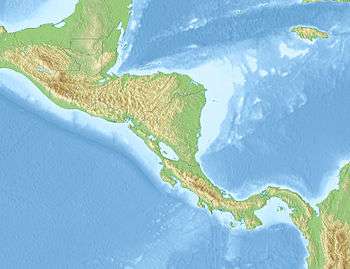1931 Nicaragua earthquake
The 1931 Nicaragua earthquake devastated Nicaragua's capital city Managua on 31 March. It had a moment magnitude of 6.1 and a maximum MSK intensity of VI (Strong). Between 1,000 and 2,450 people were killed. A major fire started and destroyed thousands of structures, burning into the next day. At least 45,000 were left homeless and losses of $35 million were recorded.[4]
 Managua | |
| UTC time | 1931-03-31 16:02:19 |
|---|---|
| ISC event | 906694 |
| USGS-ANSS | n/a |
| Local date | 31 March 1931 |
| Local time | 10:02 |
| Magnitude | 6.1 Mw [1] |
| Depth | 15 km (9.3 mi) [1] |
| Epicenter | 12.57°N 87.45°W [1] |
| Areas affected | Nicaragua |
| Total damage | $15–35 million [2] |
| Max. intensity | VI (Strong) [3] |
| Casualties | 1,000–2,450 [2][4] 45,000 displaced [4] |
Earthquake and aftermath
The earthquake hit Managua at 10:19 AM on 31 March, and caused cracks to spread throughout the western side of the city. East Managua was largely untouched.[5] The quake was largely centered in Managua. Granada, Nicaragua was unaffected.[6]
The earthquake caused a large fire, which burned for five days, destroying 33 blocks in "the richest and most important area of the city". All major government buildings in the city except for the National Bank of Nicaragua and most of the nation's archives were destroyed. The city, which at the time had a population of around 60,000 people, saw the vast majority left homeless. Ernest J. Swift, the director of relief efforts undertaken by the American Red Cross, estimated damages at around $15 million.[7] The most deaths occurred in the city's penitentiary.[8]
American marines and the Gaurdia Nacional immediately began working to restore order in Managua. American navy soldiers established a hospital while army soldiers fought the fire.[7] Daniel I. Sultan, an American soldier who was leading the Nicaragua Canal Survey, organized a relief team of 34 soldiers, and was on an emergency committee for responding. He was charged with overseeing the restoration of railroads and water to the city, and chaired a food relief committee that provided 24,000 rations daily by April 24.[8] The American Red Cross initially provided $10,000 towards relief, before increasing the amount to $100,000. People from Mexico and Panama, as well as other Central American countries, were sent to assist in relief and rebuilding efforts.[7] America flew in medical supplies, working to prevent the outbreak of various diseases.[9]
Rebuilding
In March 1932, The New York Times reported that "the Nicaraguan capital Is slowly emerging from ruins caused by 1931 earthquake". Rents fell by 40% in the year following the earthquake, and the city had slowly been rebuilding. Efforts were hampered by a lack of funding.[10] The city was eventually rebuilt in the Spanish Colonial architecture style.[11]
References
- ISC (2017), ISC-GEM Global Instrumental Earthquake Catalogue (1900–2013), Version 4.0, International Seismological Centre
- USGS (September 4, 2009), PAGER-CAT Earthquake Catalog, Version 2008_06.1, United States Geological Survey
- Ambraseys, N. N.; Adams, R. D. (2000), The Seismicity of Central America – A Descriptive Catalogue 1898–1995, Imperial College Press, p. 235, doi:10.1142/9781848160118_0001, ISBN 978-1860942440
- Toronto Star, April 1, 1931
- Managua, Nicaragua Earthquake of December 23, 1972. Earthquake Engineering Research Institute. 1973. p. 7.
- Sozen, Mete Avni; Matthiesen, R. B. (1975). Engineering Report on the Managua Earthquake of 23 December 1972: A Report. National Academy of Sciences. p. 6.
- The United States and Nicaragua: A Survey of the Relations from 1909 to 1932. United States Department of State. 1932. p. 112.
- Brodhead 2013, pp. 28-29.
- Boot, Max (2014-03-11). The Savage Wars Of Peace: Small Wars And The Rise Of American Power. Basic Books. p. 248. ISBN 978-0-465-03866-4.
- "MANAGUA DELAYED BY LACK OF MONEY: But the Nicaraguan Capital Is Slowly Emerging From Ruins Caused by 1931 Earthquake". The New York Times. March 20, 1932.
- Lee, David Johnson (2015). "De-centring Managua: post-earthquake reconstruction and revolution in Nicaragua". Urban History. 42 (4): 663–685. doi:10.1017/S0963926815000577. ISSN 0963-9268.
- Brodhead, Michael J. (2013). ""A Wet, Nasty Job": Army Engineers and the Nicaragua Canal Survey of 1929–1931" (PDF). Society for History in the Federal Government.